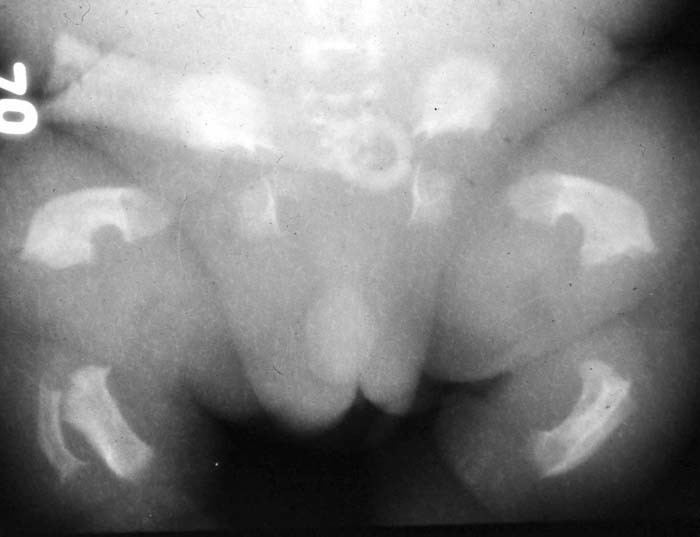Specialty medical genetics OMIM 187600 eMedicine ped/2233 | ICD-10 Q77.1 DiseasesDB 29403 MeSH D013796 | |
 | ||
Thanatophoric dysplasia (thanatophoric dwarfism) is a severe skeletal disorder characterized by a disproportionately small ribcage, extremely short limbs and folds of extra skin on the arms and legs.
Contents
Symptoms
Infants with this condition have disproportionately short arms and legs with extra folds of skin. Other signs of the disorder include a narrow chest, small ribs, underdeveloped lungs, and an enlarged head with a large forehead and prominent, wide-spaced eyes. Thanatophoric dysplasia is a lethal skeletal dysplasia divided into two subtypes. Type I is characterized by extreme rhizomelia, bowed long bones, narrow thorax, a relatively large head, normal trunk length and absent cloverleaf skull. The spine shows platyspondyly, the cranium has a short base, and, frequently, the foramen magnum is decreased in size. The forehead is prominent, and hypertelorism and a saddle nose may be present. Hands and feet are normal, but fingers are short. Type II is characterized by short, straight long bones and cloverleaf skull. It presents with typical telephone handled shaped long bones and a H-shaped vertebrae.
Causes
It can be associated with missense mutations in fibroblast growth factor receptor-3.
Classification
Infants with type 1 thanatophoric dysplasia also have curved thigh bones, flattened bones of the spine (platyspondyly) and shortened thoracic ribs. Note: Prenatal ultra-sound images of the ribs sometimes appear asymmetrical when in fact they are not. In certain cases, this has caused a misdiagnosis of Osteogenisis Imperfecta (OI) type II.
An unusual head shape called kleeblattschädel ("cloverleaf skull") can be seen with type 2 thanatophoric dysplasia.
Prognosis
The term thanatophoric is Greek for "death bearing". Children with this condition are usually stillborn or die shortly after birth from respiratory failure, however a small number of individuals have survived into childhood and a very few beyond. Survivors have difficulty breathing on their own and require respiratory support such as high flow oxygen through a canula or ventilator support via tracheostomy. There may also be evidence of spinal stenosis and seizures. The oldest known living TD survivor is a 29-year-old female. One male lived to be 26 years old. Another male lived to age 20. TD survivor, Chrisopher Álvarez, 18, is Colombian living in New York. Two children with TD aged 10 and 12, a male and a female, are known in Germany. There is also a 6-year-old male living with TD and two 1-year old males.
Incidence and prevalence
This condition affects about 1 in 60,000 births.
